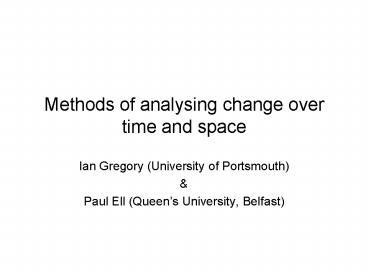Methods of analysing change over time and space - PowerPoint PPT Presentation
1 / 15
Title:
Methods of analysing change over time and space
Description:
... strengths and weaknesses Other sources Bringing them together Spatial analysis with GWR Geographically Weighted Regression Example Mapping the R2i ... – PowerPoint PPT presentation
Number of Views:110
Avg rating:3.0/5.0
Title: Methods of analysing change over time and space
1
Methods of analysing change over time and space
- Ian Gregory (University of Portsmouth)
- Paul Ell (Queens University, Belfast)
2
Advantages of temporal GIS data
- 1. Integration
- Potentially any data with a spatial and a
temporal reference can be integrated - Allows new data to be created
- 2. Analysis
- Need to spot broad trends and places/times that
show different patterns - Only limited techniques available
- Multi-level modelling
- Geographically Weighted Regression (GWR)
- 3. Visualisation
- Allows exploration of data and presentation of
results - In all cases we want to make best use of all of
the available detail in the data (attribute,
spatial and temporal)
3
Data integration District-level net migration
rates
- Net migration from the basic demographic
equation - NMt,tn (ptn pt) - (Bt,tn - Dt,t
n) - Age and sex specific population, fertility and
mortality data have been published decennially in
Britain since the 1850s - Net migration for women aged 5 to 14 at the start
of the decade can be calculated as - Females aged 15 to 24 at end of decade minus
females aged 5 to 14 at start of decade minus
number of deaths in the cohort through the decade - Problem As net migration is the residual it is
highly susceptible to error. In particular, the
impact of any boundary changes will appear as
migration. - Traditional studies
- Most studies of net migration use county-level
data to avoid boundary change issues - Only use the census so are unable to sub-divide
migrants by age/sex
4
Net migration through areal interpolation
- Standardise population and mortality data from
many dates onto a single set of target units - Integrate data from census and Registrar
Generals Decennial Supplement - Allows us to calculate net migration rates for
males and females in ten-year cohorts from ages 5
to 14 to ages 55 to 64 (at start of decade).
5
Standardised time-series
Net migration rates among the 5 to 14 cohort
Bristol
Cheltenham
Westbury
6
Detailed attribute comparisons
Net migration rates among different cohorts in
the 1920s
Bristol
Cheltenham
Westbury
7
Net migration strengths and weaknesses
- Strengths
- From the census (comprehensive)
- Can compute complete time-series from 1851-2001
- Can be integrated with other aggregate
information - Pop. density
- Employment
- Social class
- Proximity to coast/areas of natural beauty, etc.
- Weaknesses
- No information on flows
- Low net mig. can be caused by high in and out
mig. cancelling each other out - Ecological fallacy when analysing data
8
Other sources
- Pooley Turnbull (1996)
- Sample of 75,000 migrations by 16,000 people born
1750-1930 created using genealogical societies. - Gives
- Where each move was to and from (including grid
references) - When the move occurred
- Large amounts of attribute information on
employment, family structure, etc. - Strengths
- Detailed individual-level info
- Weaknesses
- Potentially biased sample
- Doesnt include the young up to the present
9
Bringing them together
- Both datasets are geo-referenced can be
integrated - Allows
- Comparison of individual-level and ecological
data (use of multi-level modelling) - Tests whether ecological and individual level
relationships are consistent - Evaluates the accuracy of the sample
- Therefore
- Integrates different datasets
- Makes full use of spatial, attribute and temporal
information
10
Spatial analysis with GWR
- Global vs local analysis
- Global analysis
- Gives a single summary statistic or equation for
whole study area - Average relationship implies spatial
homogeneity - Local analysis
- Allows parameters to vary over space
- Shows how relationships vary geographically
- Allows spatial heterogeneity
11
Geographically Weighted Regression
- Descriptive Allows the relationship between the
variables to vary over space by providing
separate intercept and regression coefficients
for every location on the map - Test as to whether the model shows significant
spatial variation - Conventional regression yia0a1x1ia2x2iei
- GWR yia0(ui,vi)a1(ui,vi)x1ia2(ui,vi)x2iei
- (ui,vi) represents the coordinates of the ith
point and an(ui,vi) is the impact of an(u,v) at
the ith point. This is implemented using a
distance decay model
12
Example
- Global LTLIi3.896.6UNEMi31.1CROWi-3.5SPFi-22.5
SC1i-5.6DENSi
Intercept
SC1
UNEM
DENS
13
Mapping the R2i values
Source Fotheringham et al, 1998
14
Uses in spatio-temporal analysis
- In C19 young women migrated as much as men but
the spatial pattern differed significantly
because of the different employment opportunities
(main employers domestic service, textiles) - Conventional regression
- Mig proportional to DS and Text
- GWR
- Textiles attract women in Lancs/W. York
- DS attracts women to wealthy areas eg West
London, Cheltenham, Leamington Spa - Over time this pattern will become more complex
and the differences between men and women will
reduce
15
(No Transcript)































